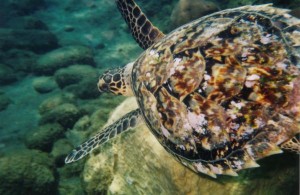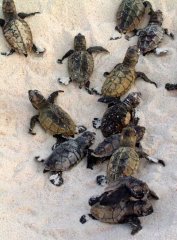There are many endangered species in our planet where some animals are becoming rarer due to many factors like habitat constraints or poaching. The Hawksbill Sea Turtle (Eretmochelys imbricata) is one of those animals with its population decreasing due to a many elements. Some of these include commercial exploitation, habitat loss and amazingly their monogamy is also to blame.

Their carapace is commercially valuable, which makes these turtles prime victims.
Photo Credits: Johan Chevalier
In an attempt to understand these turtles’ way of life underwater, scientists started analyzing their DNA and those of their offspring.
Female Hawksbills have the ability to carry sperm for up to 75 days in such a way that this accommodates for the long journey to shore where eggs are laid. Now, sea turtles in general are actually polygamous. This increases offspring diversity and it is very common to see a variety of fathers in offspring from the same nest since female turtles mate with many partners during mating season. That’s where Hawksbill Sea Turtles are different.

A nest of Hawksbill Turtles all from the same father due to monogamous mothers, unlike most other species of sea turtles in the world.
Credits: www.seaturtlenet.com
By DNA analysis it was concluded that a female Hawksbill only mates with one partner per mating season. Keeping in mind that a mating season comes every 2-4 years for a regular sea turtle, this is quite a commitment. This would not have been possible to conclude, however, from mere observation alone. Since sea turtles mate in the deep ocean, the only way to arise to this conclusion has been through DNA analysis. Further analysis, also concluded that female Hawksbills are also not selecting ‘better quality’ males to mate with either.
Quite simply, DNA is the reason behind the story of a Hawksbill’s fidelity coming to light. To mate with a single male and not be selective, sounds like loyalty to me. In the Hawksbill’s case, this is not playing out to their favor though. A less diverse population of offspring means less chances of survival for the hatch-lings.
With the help of Dr. David Richardson (lead researcher in the turtle’s DNA analysis) having narrowed down times of mating, now conservationists will be able to draw their focuses on target times on the season and areas of nesting.
DNA analysis now has not only uncovered a possible reason for endangerment to a species, but now could also be its salvation.
